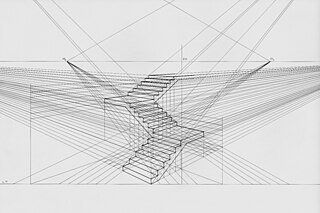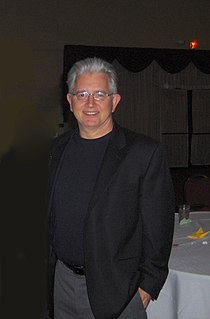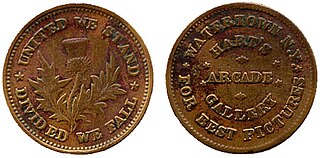Computer vision is an interdisciplinary scientific field that deals with how computers can gain high-level understanding from digital images or videos. From the perspective of engineering, it seeks to understand and automate tasks that the human visual system can do.

The loonie, formally the Canadian one-dollar coin, is a gold-coloured Canadian coin that was introduced in 1987 and is produced by the Royal Canadian Mint at its facility in Winnipeg. The most prevalent versions of the coin show a common loon, a bird found throughout Canada, on the reverse and Queen Elizabeth II, the nation's head of state, on the obverse. Various commemorative and specimen-set editions of the coin with special designs replacing the loon on the reverse have been minted over the years.

A panorama is any wide-angle view or representation of a physical space, whether in painting, drawing, photography, film, seismic images or a three-dimensional model. The word was originally coined in the 18th century by the English painter Robert Barker to describe his panoramic paintings of Edinburgh and London. The motion-picture term panning is derived from panorama.

Obverse and its opposite, reverse, refer to the two flat faces of coins and some other two-sided objects, including paper money, flags, seals, medals, drawings, old master prints and other works of art, and printed fabrics. In this usage, obverse means the front face of the object and reverse means the back face. The obverse of a coin is commonly called heads, because it often depicts the head of a prominent person, and the reverse tails.

Linear or point-projection perspective is one of two types of graphical projection perspective in the graphic arts; the other is parallel projection. Linear perspective is an approximate representation, generally on a flat surface, of an image as it is seen by the eye. The most characteristic features of linear perspective are that objects appear smaller as their distance from the observer increases, and that they are subject to foreshortening, meaning that an object's dimensions along the line of sight appear shorter than its dimensions across the line of sight. All objects will recede to points in the distance, usually along the horizon line, but also above and below the horizon line depending on the view used.

A vanishing point is a point on the image plane of a perspective drawing where the two-dimensional perspective projections of mutually parallel lines in three-dimensional space appear to converge. When the set of parallel lines is perpendicular to a picture plane, the construction is known as one-point perspective, and their vanishing point corresponds to the oculus, or "eye point", from which the image should be viewed for correct perspective geometry. Traditional linear drawings use objects with one to three sets of parallels, defining one to three vanishing points.

Coin magic is the manipulating of coins to entertain audiences. Because coins are small, most coin tricks are considered close-up magic or table magic, as the audience must be close to the performer to see the effects. Though stage conjurers generally do not use coin effects, coin magic is sometimes performed onstage using large coins. In a different type of performance setting, a close-up coin magician will use a large video projector so the audience can see the magic on a big screen. Coin magic is generally considered harder to master than other close-up techniques such as card magic, as it requires great skill and grace to perform convincingly, and this requires much practice to acquire.

Visual memory describes the relationship between perceptual processing and the encoding, storage and retrieval of the resulting neural representations. Visual memory occurs over a broad time range spanning from eye movements to years in order to visually navigate to a previously visited location. Visual memory is a form of memory which preserves some characteristics of our senses pertaining to visual experience. We are able to place in memory visual information which resembles objects, places, animals or people in a mental image. The experience of visual memory is also referred to as the mind's eye through which we can retrieve from our memory a mental image of original objects, places, animals or people. Visual memory is one of several cognitive systems, which are all interconnected parts that combine to form the human memory. Types of palinopsia, the persistence or recurrence of a visual image after the stimulus has been removed, is a dysfunction of visual memory.
This is a glossary of conjuring terms used by magicians.

The French drop, also known as "Le Tourniquet", is a sleight of hand method used by magicians to vanish a small object such as a coin or ball. It is one of the oldest methods of vanishing, however it is still effective when properly executed. Although the method is known as a vanish, it can also be used as a switch or transformation, giving rise to numerous possibilities.
In the retention of vision vanish, the magician places a coin or small object between the fingers and the thumb of the right hand. The left hand is palm up with the palm slightly tilted towards the audience. The right approaches and displays the object on the left palm for a second or so, held on opposite sides of a diameter. Then the right hand moves away empty as the fingers of the left hand close over the object. After a brief pause the left hand is shown empty and the coin has disappeared. In some versions the right hand can also be seen empty, leaving no clue as to where the coin went.

Palming is a technique for holding or concealing an object in the hand. It is used frequently by magicians to conceal a card, coin, or other object. When it is done skillfully, the hand containing the palmed object is perceived to be completely empty.

Paul Gertner is an American close-up magician from Pittsburgh. He is best known in the magic world for his Steel and Silver book and set of DVDs.

Vanishing Vision is the debut studio album by Japanese heavy metal band X Japan, then known as simply X. It was released on April 14, 1988 by Extasy Records, topped the Oricon indies chart and reached number 19 on the main chart.

Civil War tokens are token coins that were privately minted and distributed in the United States between 1861 and 1864. They were used mainly in the Northeast and Midwest. The widespread use of the tokens was a result of the scarcity of government-issued cents during the Civil War.

David Roth was an American magician widely regarded as one of the world's greatest coin magicians. Roth was an important contributor to Richard Kaufman's Coinmagic, an influential text on contemporary coin technique; his major work was chronicled in David Roth's Expert Coin Magic, a book written by Richard Kaufman. Roth was associated with Fantasma Magic, a magic manufacturing and retail company in New York City before going to work for the Conjuring Arts Research Center during the last decade of his life.
The Best Coin Fold is the title of a magic trick (effect) which appeared in Jean Hugard's book, Close Up Magic, published in 1938. A coin fold is an effect that involves the appearance of a magician folding a coin up within a piece of paper seemingly trapping the coin therein. The magician then causes the coin to vanish and (often) reappear elsewhere. Magic literature contains numerous references to coin fold techniques and presentations. The "trick" is built around special procedures or techniques in folding the paper such that it appears that the coin is trapped, but in fact it easily slides out undetected by the spectator.

Close-up magic is magic performed in an intimate setting usually no more than 3 meters from one's audience and is usually performed while sitting at a table.
The Coin of the Year Award (COTY) is an awards program founded and annually conducted by the American publisher Krause Publications of Iola, Wisconsin, and directed at the coin producing industry. Awards are given for numismatic design, artistic vision and craftsmanship. A panel of international judges chooses the coins from those issued two years prior to the year of the award.














